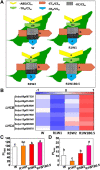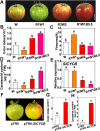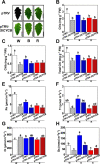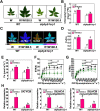Light quality regulates plant biomass and fruit quality through a photoreceptor-dependent HY5-LHC/CYCB module in tomato
- PMID: 38077493
- PMCID: PMC10699845
- DOI: 10.1093/hr/uhad219
Light quality regulates plant biomass and fruit quality through a photoreceptor-dependent HY5-LHC/CYCB module in tomato
Abstract
Increasing photosynthesis and light capture offers possibilities for improving crop yield and provides a sustainable way to meet the increasing global demand for food. However, the poor light transmittance of transparent plastic films and shade avoidance at high planting density seriously reduce photosynthesis and alter fruit quality in vegetable crops, and therefore it is important to investigate the mechanisms of light signaling regulation of photosynthesis and metabolism in tomato (Solanum lycopersicum). Here, a combination of red, blue, and white (R1W1B0.5) light promoted the accumulation of chlorophyll, carotenoid, and anthocyanin, and enhanced photosynthesis and electron transport rates by increasing the density of active reaction centers and the expression of the genes LIGHT-HARVESTING COMPLEX B (SlLHCB) and A (SlLHCA), resulting in increased plant biomass. In addition, R1W1B0.5 light induced carotenoid accumulation and fruit ripening by decreasing the expression of LYCOPENE β-CYCLASE (SlCYCB). Disruption of SlCYCB largely induced fruit lycopene accumulation, and reduced chlorophyll content and photosynthesis in leaves under red, blue, and white light. Molecular studies showed that ELONGATED HYPOCOTYL 5 (SlHY5) directly activated SlCYCB, SlLHCB, and SlLHCA expression to enhance chlorophyll accumulation and photosynthesis. Furthermore, R1W1B0.5 light-induced chlorophyll accumulation, photosynthesis, and SlHY5 expression were largely decreased in the slphyb1cry1 mutant. Collectively, R1W1B0.5 light noticeably promoted photosynthesis, biomass, and fruit quality through the photoreceptor (SlPHYB1 and SlCRY1)-SlHY5-SlLHCA/B/SlCYCB module in tomato. Thus, the manipulation of light environments in protected agriculture is a crucial tool to regulate the two vital agronomic traits related to crop production efficiency and fruit nutritional quality in tomato.
© The Author(s) 2023. Published by Oxford University Press on behalf of Nanjing Agricultural University.
Conflict of interest statement
The authors declare that they have no competing interest.
Figures









References
-
- Flynn DFB, Wolkovich EM. Temperature and photoperiod drive spring phenology across all species in a temperate forest community. New Phytol. 2018;219:1353–62 - PubMed
-
- Nakane Y, Yoshimura T. Photoperiodic regulation of reproduction in vertebrates. Annu Rev Anim Biosci. 2019;7:173–94 - PubMed
-
- Kramer DM, Avenson TJ, Edwards GE. Dynamic flexibility in the light reactions of photosynthesis governed by both electron and proton transfer reactions. Trends Plant Sci. 2004;9:349–57 - PubMed
-
- Armbruster U, Correa Galvis V, Kunz HH. et al. . The regulation of the chloroplast proton motive force plays a key role for photosynthesis in fluctuating light. Curr Opin Plant Biol. 2017;37:56–62 - PubMed
-
- Ouzounis T, Rosenqvist E, Ottosen CO. Spectral effects of artificial light on plant physiology and secondary metabolism: a review. HortScience. 2015;50:1128–35
LinkOut - more resources
Full Text Sources

